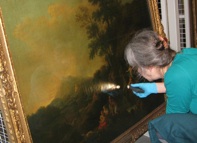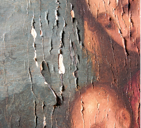Sylvia Krauss Paintings Conservation
Services
Costs
Recommendations for treatment and estimates or quotations of costs can only be made after initial examination of the artwork. This will normally not be charged for, but costs may arise and will be agreed on in advance, if travelling over longer distances is required or the examination is for a more complicated project. In conservation the main costs usually are due to the time involved and whilst treatments will not be charged for by the hour, an hourly rate of £38 will be used to calculate costed estimates/quotes. For a first clarification it can often be very helpful to send an image of the work to be treated or details of the problem areas.
Insurance
Sylvia Krauss Paintings Conservation operates with full insurance cover in public/products liability and professional indemnity. Insurance cover is also in place for goods in trust and transit up to a certain value, but if necessary clients will be advised to provide continued cover through their own insurers. The studio offers a very secure environment with double locking and 24 hour CCTV surveillance of the building.
Examination and Documentation

Packing and transport to and from the conservation studio can be provided depending on insurance value and size of the artwork. Alternatively it can be arranged for by using a professional art logistics company.

Comprehensive and thorough condition reports can be provided for works of art intended to go on loan. Sylvia is also available to accompany transports as courier and supervise the installation or de-installation of exhibitions. In addition to experience gained during previous employment, she also has regularly been working for the National Galleries of Scotland on loans preparations and exhibition installation.
© *1
© *1
© *1



© *1





*1 Image © and courtesy of CSG CIC Glasgow Museums Collection
*2 Image ⓒ David Hopes, reproduced with kind permission of the National Trust for Scotland
© *2
Structural Repair
Consolidation
Surface Cleaning, Removal of Varnish/Over-paint
Restoration
Frames, Painted Sculpture, Contemporary Art
Preventive Conservation, Storage/Display Advise
Loans/Installation
Training/Supervision of Volunteers
Packing and Transport



All clients receive a brief report about the initial condition and any treatment carried out, as well as any images taken during the process free of additional charge.
If required more extended technical examination can be carried out in the studio using stereo microscopy and UV light, both with optional digital photography. Infrared and X-ray imaging or analysis of materials may be arranged on a contracting out basis. Apart from individual examinations, condition surveys for whole collections are also carried out and documented.
Structural repair includes any steps necessary to stabilise the support of a painting/object. This might be canvas, the stretcher/strainer, a wooden panel or any other material serving as support. There might be tears, punctures, deformations, splits, cracks or general weakening of materials. Repairs are carried out with a preference towards minimal interference wherever possible. As example, damages in relatively young canvas can be repaired using surgical needle and thread (see picture) or torn thread ends may be glued together again one by one along a tear.
Paint and/or ground layers can loose adhesion or cohesion for various reasons. Consolidation is the reattachment of those layers to the support or each other. A number of stable adhesives are available in conservation, which will be chosen according to the requirements in each case. Usually the process also involves the use of some gentle heat and/or pressure provided for example by a heated spatula.
The appearance of an artwork can have altered or even become disfigured by dirt on the surface, aged varnish or previous restorations in the form of discoloured retouching or over-paint.
After deciding on the pros and cons to do so, the possibility to remove any of those layers will be tested carefully with cleaning agents, solvents or mechanical methods to minimise risks to the original paint before work commences.
Where conservation and stabilisation prevent further untimely deterioration of an artwork, restoration improves the aesthetic appearance through reconstruction of lost material. Typically this might include the filling of losses and the optical integration of those areas by retouching. Retouching can be kept minimal, aiming only to soften or unify areas of loss in a neutral tone, or it can be carried out to a high level making it almost invisible to the naked eye. Restoration might also include the application of a new varnish layer.
Frames and painted sculpture will be treated in as far as they can be regarded as three dimensional paintings. For more specific treatments of a structural nature, help might be enlisted from specialised colleagues.
Contemporary art (painting and three dimensional objects) often consists of many non-traditional materials for which tested treatment methods are rarely available. This requires an open minded and critical approach. An example is the repair in the pictures on the left, on an object made from polyurethane foam.
Whilst the natural ageing process of artworks can not be stopped completely, there are various measures that will help to prevent any new damage and slow ageing down as far as possible. Advise and implementation of optimal environmental conditions for storage or display are an important part of this. The fitting of some loose support like a stretcher bar lining or a wadding infill (see picture) or conservation framing can also contribute a lot to the future stability of a painting.
Sylvia is experienced in training and supervising groups of volunteers for projects such as cataloguing, packing and basic surface cleaning of objects.